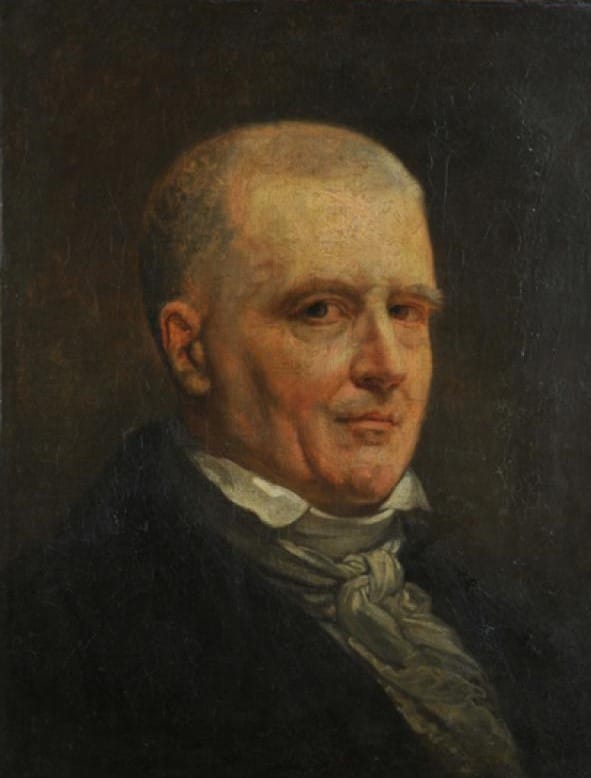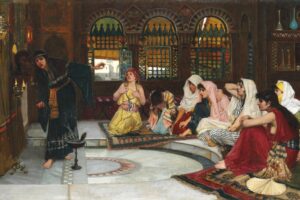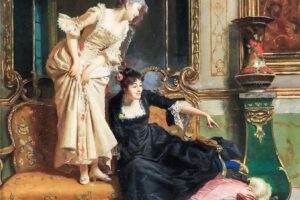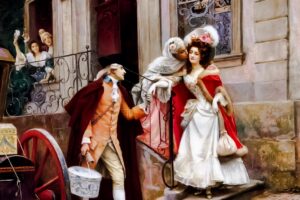Imagine a peaceful, sunny day far away from the noise of any busy town. The air is fresh, the grass is soft, and the only sounds are the gentle bleating of sheep and the whisper of leaves in the breeze. That’s the tranquil world Jean Honoré Fragonard invites us into with his charming painting The Shepherdess, created around 1750–1752.
Fragonard, a master of the Rococo style, often painted scenes that felt light, romantic, and full of life’s simple pleasures—and this painting is a perfect example.
Meet the Shepherdess
At the heart of the painting sits a young woman, enjoying a quiet moment outdoors.
- Her Graceful Pose: She’s seated comfortably, leaning against what might be a stone wall or a grassy rise. Her posture is relaxed, yet elegant—graceful without trying too hard.
- Her Clothing: She wears a soft white blouse with puffed sleeves, a fitted corset in gentle pink and blue, and a flowing skirt in golden yellow and pale blue. The colors are delicate and harmonious, reflecting the soft, joyful palette of the Rococo era.
- A Whimsical Touch: She holds a garland of flowers in her hands, lifting it as if admiring her work or preparing to wear it. On her forehead rests a small white mask—an accessory from masquerade parties of the time, adding a playful hint of mystery. Her gaze is dreamy, perhaps lost in thought or enjoying the moment.
Her Companions and Her World
The shepherdess isn’t alone. Around her, small details fill the scene with warmth and life.
- A Gentle Sheep lies beside her, its quiet presence reminding us of her role and adding a comforting touch to the scene.
- A Shepherd’s Staff and Hat rest nearby—a long crook used to guide sheep, and a wide straw hat with a soft blue ribbon, laid casually on the ground.
- A Basket of Blossoms overflows with freshly picked flowers in red, blue, pink, and yellow. Perhaps she has been gathering them just for fun, or to weave into garlands like the one in her hands.
- A Surprising Companion: Perched beside her is a small monkey—a playful and exotic touch that brings a bit of surprise and humor to this otherwise gentle rural scene. Monkeys in Rococo art often symbolized amusement or even a hint of mischief.
A Peaceful Landscape
The setting is lush and inviting. Trees arch gently overhead, their branches forming a natural canopy. To the left, more sheep graze in the distance. A small figure—a possible companion or fellow shepherd—can be seen in the background, adding a hint of story to the scene. On the right, hints of a rustic fence or simple farm structure blend into the greenery. The soft blue sky above completes this idyllic moment.
A Glimpse of Rococo Joy
The Shepherdess doesn’t tell a grand tale—it celebrates stillness, beauty, and the charm of quiet country life. Fragonard gives us more than a picture; he gives us a feeling. The soft colors, flowing lines, and gentle atmosphere invite us to pause and enjoy life’s simplest moments: a garland of flowers, the sun on your skin, or the quiet company of a curious sheep.
This painting is a window into the Rococo world—a time that loved elegance, ease, and a little playfulness. And through this shepherdess’s peaceful daydream, Fragonard reminds us that happiness can be found in the simplest of things.
About Artist

Jean-Honoré Fragonard (1732–1806) was a French painter and printmaker who is considered one of the leading figures of the Rococo art movement. His style is a vibrant and fluid expression of the late Rococo, known for its lightheartedness, sensuality, and free-flowing brushwork. Unlike his contemporary Boucher, whose work could sometimes feel more formal, Fragonard’s paintings have a spontaneous and energetic quality that perfectly captured the spirit of the French aristocracy on the eve of the revolution.
Artistic Style and Legacy
Fragonard was a student of François Boucher, and he inherited his master’s love for mythological and pastoral themes. However, Fragonard’s style is more dynamic and painterly, with a liveliness all his own. His work is characterized by:
- Energetic Brushwork: His brushstrokes are visible and expressive, creating a sense of movement and spontaneity.
- Lush, Luminous Color: He used a rich and glowing palette, with shimmering whites, rose, and gold.
- Playful Sensuality: He often depicted scenes of romantic trysts, playful games, and idyllic moments of love, with a light and often erotic touch.
Fragonard’s art fell out of fashion during the Neoclassical period, which favored more serious, moralizing subjects. He died in obscurity, but his reputation was revived in the 19th century, and he is now celebrated as a master of the Rococo.
Artwork Profile
All of the paintings you mentioned are indeed by Jean-Honoré Fragonard. They are excellent examples of his style and a testament to his genius.
- The Swing (c. 1767): This is arguably Fragonard’s most famous painting and a quintessential work of the Rococo period. It depicts a young woman on a swing, with her suitor hiding in the bushes below, catching a glimpse of her as she kicks off her shoe. The lush, overgrown garden, the playful sensuality, and the charming narrative make it an icon of the era.
- The Lover Crowned (c. 1771-1772): Part of a famous series known as “The Progress of Love,” this painting shows a young woman crowning her lover with a wreath of flowers. The scene is filled with a sense of joyous, unrestrained romance.
- The Musical Contest (c. 1754): An early work from his Italian period, it shows a group of young people engaged in a musical game, demonstrating his early interest in playful social scenes.
- The Shepherdess (c. 1760): A charming example of his pastoral scenes, it depicts an idealized country girl in a beautiful, natural setting.
- Blind Man’s Buff (c. 1750-1752): Fragonard painted a few versions of this popular game. The one in the National Gallery of Art is a lively, outdoor scene full of energy and flirtation.
- The Happy Lovers (c. 1765): A beautiful and tender portrayal of a young couple, it perfectly captures the idealized, amorous mood of his mature style.



